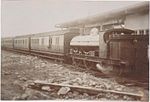RNMD Milford Haven
Ammunition dumps in PembrokeshireBuildings and structures in Milford HavenBuildings and structures in PembrokeshireIndustrial railways in WalesMilitary installations in Wales ... and 2 more
Royal Navy shore establishmentsUse British English from June 2013

RNMD Milford Haven is a "decommissioned" Royal Naval Armaments Depot located on the north shore of Milford Haven between Milford Haven and Llanstadwel in the County of Pembrokeshire, Wales. The area is known as Newton Noyes.
Excerpt from the Wikipedia article RNMD Milford Haven (License: CC BY-SA 3.0, Authors, Images).RNMD Milford Haven
Vicary Crescent,
Geographical coordinates (GPS) Address Nearby Places Show on map
Geographical coordinates (GPS)
| Latitude | Longitude |
|---|---|
| N 51.7074 ° | E -5.0195 ° |
Address
Ward's Pier
Vicary Crescent
SA73 2QE
Wales, United Kingdom
Open on Google Maps








